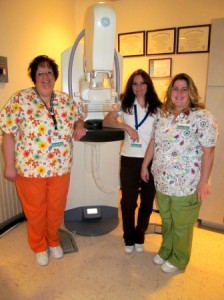
CLEARFIELD – More than 225,000 women in the United States will be found to have invasive breast cancer in 2012; about 40,000 women will die from the disease, according to the American Cancer Society.
Breast cancer death rates would drop significantly if all women age 40 and older utilized early detection methods, including mammography and clinical breast exam, said Darlene Rowles, imaging supervisor for the Clearfield Hospital.
“Through better health, vigilance and early detection, we can help make breast cancer less of a threat to ourselves and those we love. It’s important for women to know and use the tools of detection when it comes to breast cancer,” she said.
These tools are:
- Monthly breast self-exam. Learn the feel of your breasts and report any changes to your healthcare provider.
- Clinical breast exam. Have a breast exam performed by a doctor or nurse once a year for women age 40 and older, as well as for women at high risk for the disease. For women under age 40 and not at high risk, a clinical exam should be done at least once every three years.
- Mammogram. A mammogram is an x-ray exam of the breast. It is used to detect and evaluate breast abnormalities both in women who have no breast complaints or symptoms and in women who have breast symptoms (such as a lump or pain). The American Cancer Society recommends a mammogram once a year for women age 40 an older.
Rowles said though mammography rates have more than doubled for women age 50 and older since the “October is Breast Cancer Awareness Month” campaign began in 1985, there is still work to be done.
Despite professional recommendations and public support in favor of regular mammography, only about half of U.S. women get an annual mammogram, even if they have insurance to cover the test, according to the Susan G. Komen for a Cure Foundation.
“These women are putting their health in jeopardy,” Rowles said.
She said a mammogram can find cancer when it is still too small to be felt by a woman or her doctor. Finding small breast cancers early dramatically improves a woman’s chance for a positive outcome. Clearfield Hospital also offers MRI breast imaging. MRI of the breasts is often used to investigate breast concerns first detected with mammography, physical exam or other imaging exams.
Mammography personnel, Tonda Beard, Holly Bryan, Betsy Bowser, Angela Weed and Jen Wenturine are highly trained and sensitive to their patients’ needs.
“We understand that having a mammogram is a scary experience so we strive to make the experience as comfortable as possible. We’re happy to answer questions or address concerns patients have before, during and after the procedure,” said Weed, a certified mammographer and radiologic technologist who’s been with Clearfield Hospital for 11 years.
In 2009, Clearfield Hospital acquired a state-of-the-art digital mammography machine. While patients still feel compression during the procedure, the actual time it takes to have a mammogram is shorter than with traditional machines.
In the event a patient’s mammogram shows a need for further testing, Clearfield Hospital offers stereotactic breast biopsy, a minimally invasive and highly accurate procedure that helps physicians locate breast abnormalities and obtain tissue samples for diagnosis.
If cancer is detected, the Nathaniel D. Yingling, M.D., Cancer Center, located on the Clearfield Hospital campus, provides state-of-the-art medical oncology and radiation therapy.
For more information about breast health services provided by Clearfield Hospital, please call Rowles at (814) 768-2276. Community education presentations by the mammography staff may also be arranged through Rowles.
Rowles also noted that uninsured women age 40 and older may be eligible for a free mammogram through Adagio Health. For more information about this program, please call 765-9677.